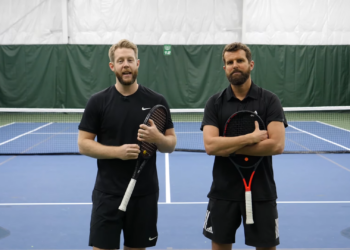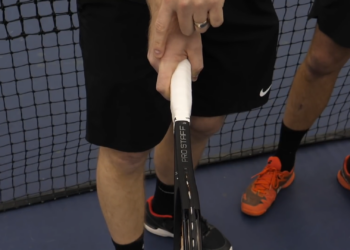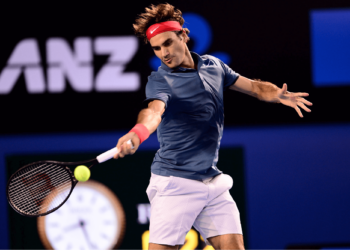If you’ve ever played a point that felt like a marathon, groundstroke after groundstroke, waiting for something to break, then you already understand why the drop shot exists.
It’s not just a flashy “finesse” shot you see Federer use to toy with opponents (though yes, it looks awesome when done right).
The drop shot is a tactical disruptor, a shot that forces your opponent to change direction, scramble forward, and often give up the point before they even reach the ball.
A proper drop shot lands just over the net and dies on impact. It’s executed with backspin and minimal forward momentum, ideally catching your opponent flat-footed at the baseline.
It’s a deliberate weapon, one that needs the right setup, timing, and technique.
Drop Shot vs. Slice vs. Short Angle
So let’s clear up the confusion: a slice is typically a defensive or neutral shot with backspin, used to keep the ball low and deep.
A short angle is usually topspin-based and designed to pull your opponent wide.
A drop shot is an offensive play with touch, it floats just over the net and stops cold, intended to end the point outright or set up an easy winner.
Why Should You Learn the Drop Shot?
I hear this from students all the time: “I don’t need drop shots ,I just want to hit harder.”
But if you want to win more matches, you need more ways to force errors, change the pace, and keep your opponent guessing. The drop shot checks all those boxes.
Disrupting Baseline Rhythm
Players today are trained to live at the baseline. The drop shot says, “Nope, come forward, let’s see if you can do something else.” It’s like hitting pause on your opponent’s rhythm and asking them to solve a whole new problem.
Creating Physical and Mental Fatigue
It’s not just the sprint, they’ve got to stop, reach, bend, and recover.
A few well-timed drop shots and suddenly their legs feel heavier, their breathing gets shorter, and their focus starts to fade. You’re managing their energy and confidence.
“I’m Afraid to Try Drop Shots in Matches…”
Totally normal. Players fear the drop shot because it feels risky. What if it floats too high? What if they run it down? What if I miss? Most of those fears come from bad timing or poor technique, not from the drop shot itself.
Once you learn how and when to hit it, it becomes one of the highest-percentage pressure tools in your arsenal.
PlayYourCourt teaches you when, why, and where. We coach you through real match scenarios, help you match with similarly-skilled partners to practice in the wild, and offer challenges that break this stuff down step-by-step.
If you’re ready to level up your tennis IQ, and finish more points without swinging harder, mastering the drop shot is your next move.
The Drop Shot Technique: Step-by-Step Mechanics
You wouldn’t build a house without a blueprint—and you shouldn’t attempt a drop shot without understanding the mechanics that make it work. A great drop shot isn’t flashy. It’s quiet, intentional, and precise.
Let’s break it down piece by piece.
The Ideal Grip for a Drop Shot
If you’re serious about control, and you should be, the continental grip is the standard for both forehand and backhand drop shots.
It positions your hand in a way that naturally opens the racket face, letting you create the delicate backspin required to “float and die” the ball over the net.
But here’s something we teach: if you’re just getting the hang of drop shots, especially on the backhand side, try using an eastern grip first. It helps lock the racket face into that open angle and gives players a better feel for the motion.
Once that muscle memory develops, you can shift back to continental without sacrificing control.
✅Pro tip: Practice both forehand and backhand drop shots. Most players only work one side, which limits your options. Your drop shot game should be ambidextrous.
Swing Path & Racket Angle
This is where most players go wrong. They either over-swing and the ball sails, or they chop too hard and the shot floats like a balloon.
What you want is what we call the “spoon technique.”
Picture using the inside of a spoon to scoop under the ball, your racket face should stay slightly open, and your motion should be gentle, almost like you’re lifting the ball into the air rather than striking it.
That cupping motion generates the spin and trajectory needed to make the shot effective without looking forced.
Keep your backswing short and compact. Think: disguise first, feel second, spin last.
How open is too open? Your racket face should create a gentle upward lift, not a sky-high lob. If the face is too open, the ball hangs and gives away the point. Find that middle ground where the ball just kisses over the net and dies.
Footwork Fundamentals
You can have the right grip, the right swing and still blow the shot if your feet don’t cooperate.
Drop shots require volley-style footwork, not baseline grinding steps.
That means getting your body weight moving forward into the ball.
For right-handers, this usually means a right-left footwork pattern (left-right for lefties). Load on the back leg, push forward, and transfer that energy softly into the shot.
This forward momentum is everything.
Ball Speed & Spin
Drop shots aren’t slow because you barely hit them, they’re slow because you hit them correctly.
Use soft contact, not a chop. Let the ball roll off your strings with a whisper of pressure. You’re not trying to beat your opponent with speed, you’re beating them with geometry.
The ideal contact point is around waist height, slightly in front of your body, and inside the service box. This keeps the angle low and helps create the spin that makes the ball stop or even bounce back toward the net.
We teach our students to blend backspin with a touch of sidespin, especially when pulling opponents off the court. This creates awkward bounce angles and keeps your opponent guessing.
✅Pro tip: Spin doesn’t mean power. In fact, when it comes to drop shots, spin = control. The better your feel for that spin, the more dangerous your drop shot becomes.
When To Use a Drop Shot (And When You Absolutely Shouldn’t)
A drop shot is a calculated weapon.
Like any weapon, it’s only effective when used at the right moment.
Use it too early, too often, or from the wrong place on the court, and it’ll blow up in your face. Use it with precision and timing, though, and your opponent won’t know what hit them.
Best Tactical Scenarios for Drop Shots
When Your Opponent Is Out of Position or Fatigued
This is drop shot 101: wait until your opponent is pushed way back behind the baseline, especially if they’ve been running side-to-side or grinding through long rallies. If they’re breathing hard or leaning back as they hit, that’s your green light.
We train our students to read not just where their opponent is, but how they’re moving.
If your opponent’s heels are behind the baseline and their weight is shifting backward, a drop shot is not only smart, it’s cruel (in the best way).
After You’ve Pushed Them Back With Deep Drives
Drop shots thrive on contrast. If you’ve been hitting deep, heavy groundstrokes, your opponent gets into a rhythm.
Break it.
After two or three deep shots, change gears with a sudden drop. It’s the tennis equivalent of a curveball after a fastball.
This is how you set up a drop shot, you don’t lead with it. You make your opponent expect depth, power, and spin… then you take it all away.
When They’re a Pusher or Baseline Grinder
You know the type, moonballs, slices, resets.
They love standing eight feet behind the baseline and making everything a war of attrition.
The drop shot is your shortcut to sanity. Bring them forward, force them out of their comfort zone, and take control of the point.
These patterns work beautifully:
- Deep crosscourt forehand → short crosscourt drop shot
- Slice to the backhand → drop shot to the forehand side
- Topspin rally → sudden drop shot when they least expect it
Just remember: pattern first, drop shot second. Strategy always beats spontaneity.
Situations To Avoid the Drop Shot
When You’re Behind the Baseline
If you’re far back, behind the baseline, you’re giving your opponent way too much time to read the shot and chase it down.
The ball has to travel further, bounce higher, and slows down before it even crosses the service line.
Here’s the golden rule: if you’re not at least on or inside the baseline, don’t even think about it.
When Your Opponent Is Near the Net
This one’s obvious, but still worth saying, if your opponent’s already up at the net, a drop shot is hand-delivering them a volley. In this case, you’re better off aiming low at their feet or lobbing over them.
If You’re Off-Balance or Rushing the Shot
Drop shots demand control. If you’re off-balance, on the run, or reaching for a tough ball, that control vanishes.
You’ll either float it or hit it into the net. Either way, it’s a free point for your opponent. Reset the point instead. Get back in position.
Overuse = Predictability
Even a good drop shot becomes useless if your opponent sees it coming. Don’t fall in love with it.
Drop shots should be used sparingly and strategically. Think of them as plot twists, not the main story.
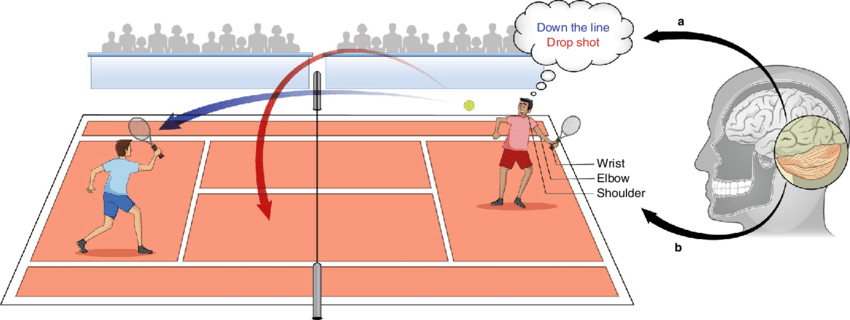
Building the Perfect Point to Set Up a Drop Shot
A great drop shot is earned.
If you want to land drop shots that win points (and not get run down by your opponent sprinting in for a highlight reel pass), you’ve got to build the point the right way.
Think of it like chess. The drop shot is your checkmate, but only if you set up the board first.
Patterns That Create Space for Drop Shots
Most players miss the opportunity to drop shot because they’re not looking at the right patterns to create space.
If your opponent is balanced, centered, and inside the baseline, forget it. But if you can stretch them, tire them, or pull them off the court, the drop shot opens up like a trapdoor.
Deep Crosscourt + Short Same-Side Drop Shot
One of the highest-percentage setups. Hit a deep crosscourt ball that pulls your opponent wide and pushes them back. As they recover, or if they don’t, you hit a drop shot to the same side.
They’ve got to cover both distance and direction change. Most don’t make it.
Wide Angle Forehand + Short Opposite-Side Drop Shot
Use a heavy topspin forehand to stretch your opponent wide, especially if they’re right-handed and on the ad side.
Once you see them off-balance or behind the baseline, surprise them with a soft drop shot to the opposite side.
They’ll have to cover the entire width of the court, and most can’t close the distance in time.
Slice Approach + Drop Shot
This one’s a favorite in PlayYourCourt workshops.
Drive a deep slice to your opponent’s backhand, most rec players struggle with low balls there.
Follow it in. If they float a reply or leave you inside the court, you’ve got the perfect setup to pull off a feather-light drop shot. You’re already in position, they’re on their heels. Game over.
Disguising Your Drop Shot
Even the best setup falls apart if you give the shot away. Disguise isn’t optional, it’s a must.
Masking With a Similar Setup to Topspin
The best drop shots come from swings that look like your regular groundstrokes.
Start the same way: same stance, same take-back. Only at the last second do you shift into the shorter, spooning motion.
Your opponent stays frozen, expecting depth, until the ball drops dead over the net.
Switching Grips Subtly Mid-Swing
This takes practice, but it’s devastating when mastered.
You start with your regular grip (say, semi-western), then switch to continental or eastern just before contact. It adds that layer of deception that makes your shot almost impossible to read.
High Take-Back = Strong Disguise
Most players telegraph their drop shot by taking the racket back low and early. That’s a dead giveaway. Instead, keep your take-back high, just like you would for a deep topspin drive.
From there, you can bail into a drop or continue through with power. Your opponent won’t know what’s coming until it’s too late and that’s the whole point.
Surface-Specific Strategy: How the Court Changes the Drop Shot
Not all courts are created equal and neither are drop shots.
The effectiveness of your drop shot can vary wildly depending on the surface you’re playing on.
What might be a winner on clay could be a gift on hard court.
If you want to master the art of drop shots, you’ve got to understand how the court surface changes the rules of engagement.
Drop Shots on Clay Courts
Clay courts are drop shot heaven.
The ball naturally bounces lower, the surface slows down your opponent’s forward movement, and sliding into the ball is tougher than sprinting on hard court.
That means your drop shots bite sooner, sit lower, and give your opponent less time to respond.
Drop Shots on Hard Courts
Hard courts are less forgiving.
The ball bounces higher, travels faster, and your opponent’s recovery time is shorter.
That means your drop shots need to be more precise, better disguised, and used far more sparingly.
If your drop shot floats or sits up on hard court, your opponent can counter-attack from it. And unlike on clay, you’re not buying extra time for recovery or follow-up.
How To Train Your Drop Shot: Drills for Feel, Control & Consistency
Drop shots are about precision, touch, and timing.
And like anything that relies on “feel,” it has to be trained.
You can’t just hit a few half-hearted attempts at the end of practice and expect to drop bombs in matches.
If you’re serious about developing buttery-soft hands, mini tennis is your best friend. Start inside the service boxes and challenge yourself to control spin and height without over-swinging.
Mini Tennis
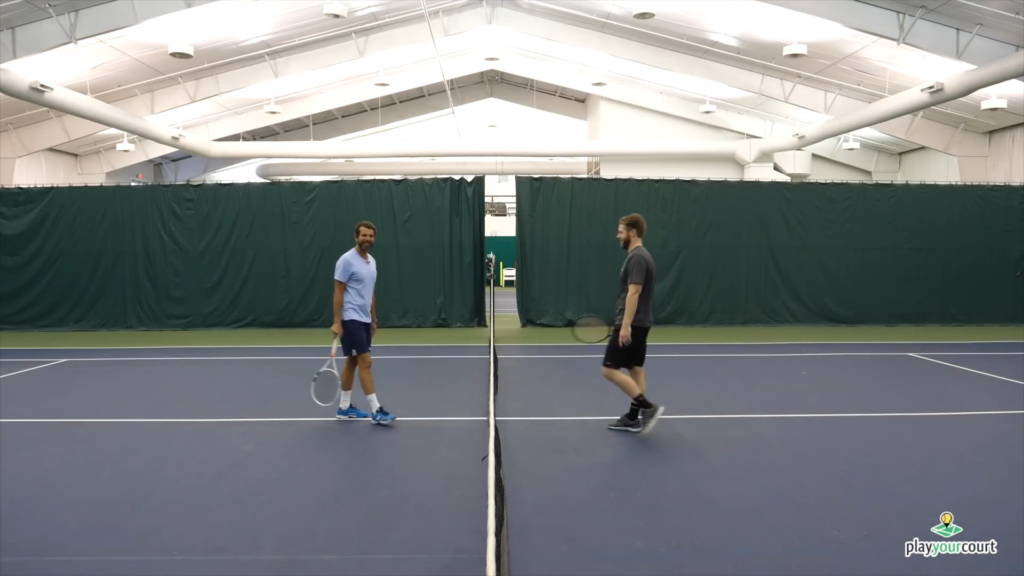
This PlayYourCourt favorite is simple: two players play points inside the service boxes, but can only win with a drop shot that bounces twice inside the service boxes. This builds instincts, soft hands, and drop shot IQ.
“Spin-to-Stop” Challenge
Another killer: hit alternating drop shots that bounce once and stop, or even come back toward the net.
You’re training control, not just placement. It also builds a deeper understanding of how spin affects bounce and ball behavior.
Mini Tennis Variations
Backspin-Only Zone Challenge
In this drill, you and your partner stay inside the service boxes and can only hit shots that generate backspin. Mark a zone near the net (like the first 3 feet) and challenge each other to land drop shots in that zone consistently. The constraint forces you to get creative with spin and angle.
Two-Bounce Box Drill
Draw or mark out a small 2×2 foot square close to the net. Your goal? Make the ball land in the box and bounce twice before your partner can touch it. It’s brutally honest, either you have the touch or you don’t.
Wall & Ball Machine Drills
Don’t have a partner? No problem. Drop shot feel can absolutely be built solo.
Short Backswing + Open-Face Contact Drill
Find a wall and get close, inside the service box range.
Use your continental grip, open your racket face, and work on softly brushing under the ball to generate lift and backspin. Focus on how little you can swing and still get the ball to the wall and back.
Ball Speed Consistency Drill
If you’ve got access to a ball machine, set it to feed slow, short balls inside the service line.
Your goal: hit five drop shots in a row that land in a tight zone near the net with consistent arc and spin. Use targets. Track how often you succeed. Improvement starts with accountability.
Drop Shots That Win Matches (Real Examples & Strategy)
The drop shot is a momentum shifter, a rhythm breaker, and yes, a match-winner.
When used strategically, it can take a player from surviving rallies to controlling the point.
Let’s walk through some real-world examples, from the pros to your local club, and break down how to use the drop shot as a killer tactic.
Case Study: Novak Djokovic’s Disguised Backhand Drop Shot
If there’s a drop shot clinic happening on tour, Novak Djokovic is usually the one running it.
Especially on clay, Novak uses the drop shot not as a last resort, but as a planned weapon. What makes his drop shot devastating is disguise.
Watch any slow-motion breakdown of his backhand drop shot, and you’ll notice this: his take-back looks identical whether he’s going to rip a backhand crosscourt or drop one just over the net.
That’s elite-level disguise. By the time his opponent realizes what’s happening, they’re already a step behind and that’s all it takes.
Club Player Pattern: Deep Rally → Sudden Drop → Net Follow-Up
We’ve coached thousands of players through this pattern because it works at every level. Here’s how it goes:
- Deep ball rally. You play a few solid groundstrokes, pushing your opponent back behind the baseline.
- Sudden drop shot. As soon as you get a slightly shorter ball and you’re inside the court, you switch gears and feather a drop shot.
- Net follow-up. You move in immediately, ready to finish the point with a volley if they chase it down.
Why does this work so well? Because 90% of club players expect the rally to continue at the same pace. The drop shot throws a wrench in the rhythm, and your follow-up shuts the door.
How to Mix In Drop Shots to Beat Pushers
Pushers, the slow ball, moonball, reset-all-day crowd, can drive even good players crazy. They don’t give you pace, they don’t miss, and they never move forward unless you drag them up there.
Enter the drop shot.
Against pushers:
- Don’t wait to be patient, be precise.
- Mix in the drop shot after pulling them wide or getting a short ball.
- Make them hit something uncomfortable, a low, short ball with pressure.
And when they finally start creeping in to defend against it? That’s when you go back to driving it deep behind them.
Next Steps: How to Master Drop Shots with PlayYourCourt
If you’ve made it this far, you’re learning that drop shots are strategy, precision, and pressure rolled into one.
Whether you’re a player stuck grinding from the baseline or a competitor looking for more tactical variety, adding a consistent, well-disguised drop shot to your toolkit can absolutely change your game.
And that’s exactly where PlayYourCourt comes in.
We’ve built our entire platform around game improvement ,not just finding partners or booking lessons, but helping players solve the exact problems that hold them back.
If you’re tired of feeling stuck at the same rating… if you’ve ever lost to a pusher and didn’t know how to break them down… or if you just want to stop playing reactive tennis and start playing tactical tennis, then mastering the drop shot is your next big leap forward.
👉 Try our PlayYourCourt membership. We’ll help you get there faster.
